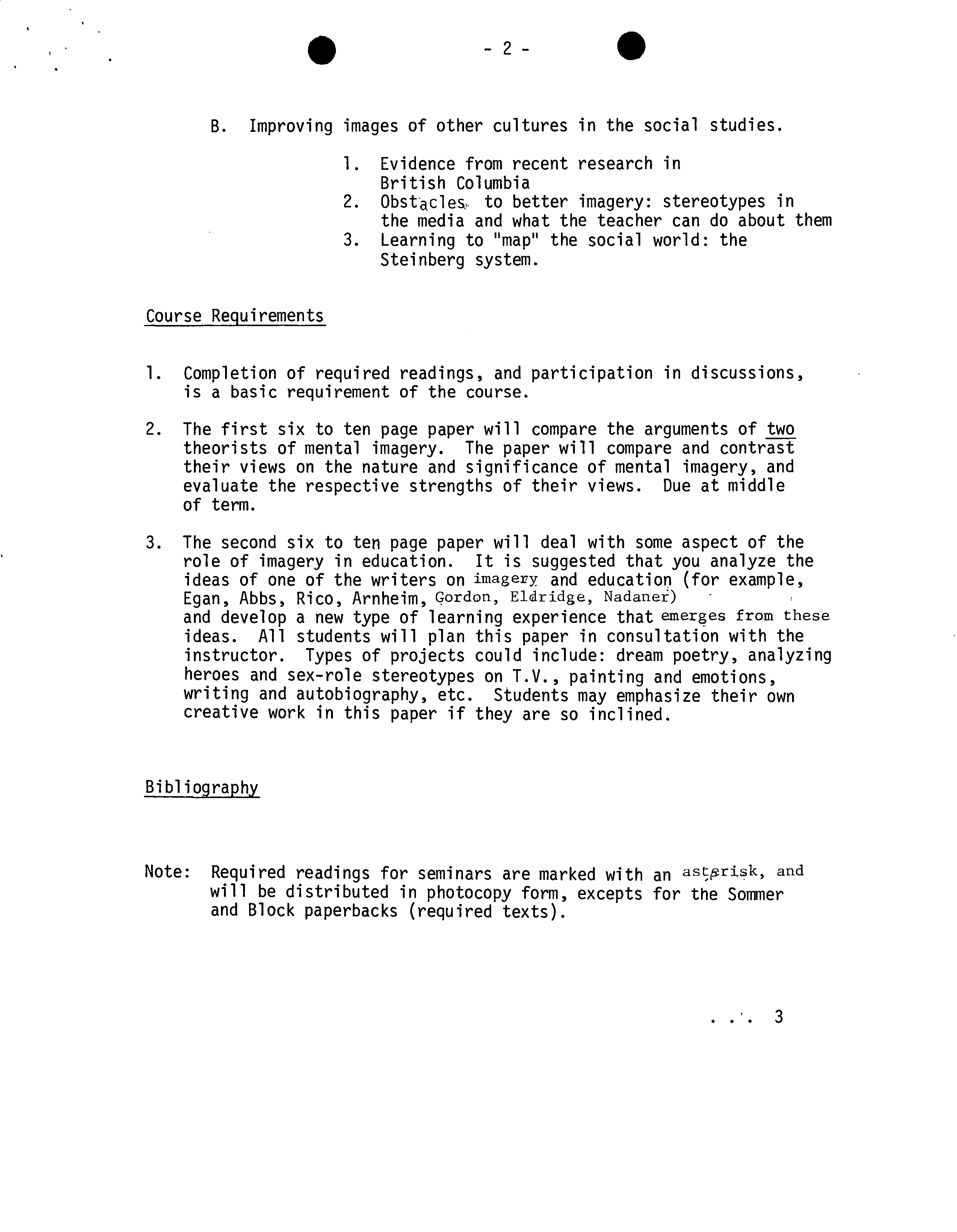• .
?
?
.
Education 488-4
The Visual Arts, Imagery, And Education
Summer Session, 1984 ?
Instructor: Dan Nadaner
Tuesdays, Thursdays, 1:00 - 4:50 ?
Location: on campus
The Visual Arts, Imagery, and Education is a seminar course open to
graduate students, and to a limited number of undergraduates, with the
consent of the instructor. The course should be of interest to students
interested in thinking processes associated with education, and with the
role of imagery in new forms of classroom activities. No background in
the visual arts is required.
The course reviews recent research on mental imagery, and explores
the role of the image in education. Specific areas to be focused on in-
cluded: imagery in writing, imagery in the visual arts, and imagery in
social studies. Course requirements consist of readings and two 6 - 10
page papers, one concerned with theories of mental imagery and one with
educational applications.
Outline of Class Sessions
1. Theories of Mental Imagery
A.
The debate: Do we think in images?
• And, if so, what are they like?
B.
Comparing evidence from several fields:
The classics, the "old" psychology, psychoanalysis,
art education, philosophy, and the "new"
cognitive psychology.
2. Potentials for Imagery In Education
A.
The natural way to think: arguments from
psychologists and educators.
B.
The natural way to write: Gabrielle Rico's
Writng The Natural Way
c. Guest lecture: imagery and other curriculum areas
3. Practical Projects: Imagery In the Arts and Social Studies
?
A. The natural way to create in the visual arts.
1.
Looking
at
drawing as a record of perceptions.
2.
Looking at painting as a record of emotions.
3.
Imagery activities for the school.
.
?
-2- ?
S
B. Improving images of other cultures in the social studies.
1.
Evidence from recent research in
British Columbia
2.
Obstacles to better imagery: stereotypes in
the media and what the teacher can do about them
3.
Learning to "map" the social world: the
Steinberg system.
Course Requirements
1. Completion of required readings, and participation in discussions,
is a basic requirement of the course.
2.
The first six to ten page paper will compare the arguments of two
theorists of mental imagery. The paper will compare and contrast
their views on the nature and significance of mental imagery, and
evaluate the respective strengths of their views. Due at middle
of term.
3.
The second six to ten page paper will deal with some aspect of the
role of imagery in education. It is suggested that you analyze the
ideas of one of the writers on
imagery
and education (for example,
Egan, Abbs, Rico, Arnheim, Gordon, Eldridge, Nadaner)
and develop a new type of learning experience that emerges from these
ideas. All students will plan this paper in consultation with the
instructor. Types of projects could include: dream poetry, analyzing
heroes and sex-role stereotypes on T-V., painting and emotions,
writing and autobiography, etc. Students may emphasize their own
creative work in this paper if they are so inclined.
Bibliography
Note: Required readings for seminars are marked with an as11risk, and
will be distributed in photocopy form, excepts for the Sommer
and Block paperbacks (required texts).
S ?
-3-
Part I: Theories of Mental Imagery
•
?
Arnheim, Rudolf.
?
Visual Thinking
•
?
Block, Ned. ?
Imagery.
Delaney, Gayle.
?
Living Your Dreams.
•
?
Gordon, Rosemary.
?
A Very Private World.
?
In
P. Sheehan,
Ed., The Function And NatUre of Imagery.
•
?
Hall, Calvin, S. What People Dream About.
?
Scientific
American. ?
184, May, 1951,
60 - 64.
•
?
Hannay, Alistair. ?
Mental ?
Images: 'A Defence.
Jung, Carl. ?
Man And His Symbols.
•
?
Kosslyn, Stephen. ?
Image And Mind.
Paivio, Alan.
?
Imagery And Verbal Processes.
Piaget, Jean. ?
Mental
?
Imagery In The Child.
Read, Herbert. ?
Education Through Art.
Ryle, Gilbert.
?
On Thinking.
Samuels, Mike.
?
Seeing with The Mind's Eye.
•
?
Shepard, Roger.
?
The Mental ?
Image. ?
American
Psychologist.
1978, 33,
?
125- ?
137.
Sheikh,:.A.A. ?
Imagery.
•
?
Sommer, Robert:
?
The Mind's Eye:
?
Imagery In
Everyday Life.
Part II: Potentials For Ima
g
er y
In Education
• Abbs, Peter. Education And The Living Image:
Reflections on Imagery, Fantasy, and The
Art Of Recognition. Teachers College Record,
82: 475 - 96, Spring, 1981.
• Egan, Kieran. Educational Development.
• Piaget, Jean. The Child's Conception Of The World.
• Rico, Gabriele. Writing The Natural Way.
Richardson, Glenn E. Educational Imagery.
Singer, Jerome. Imagination And Make-Believe Play
In Early Childhood: Some Educational Implications.
Journal Of Mental Imagery, 1977, 1, 127 - 144.
. ?
- 4 -
?
S
Part III: Practical Projects: Imagery In the Arts amd Social Studies
• B.C. Secondary Art Curriculum
• Eldridge, Arthur. Imacies of Conflict.
Gordon, Rosemary. An Investigation Into Some of the Factors that Favour
The Formation of Stereotyped images. British Journal of Psvholoqy,
39, (3), 156 - 187.
* Langer, Suzanne.
Problems of Art.
Lansing, Kenneth. The Effect of Drawing on the Development of Mental
Representations. Studies In Art Education. 22, 3, 15 - 23, 1981.
* Nadaner, Dan A Matter Of Life and Death. Vanguard, December, 1983.
* Nadaner, Dan. On Art And Social Understanding: Lessons From Alfred Schutz.
Journal of Multi-Cultural And Cross-Cultural Issues In Art
Education, 1 (1), Fall, 1983.
Schiff, Stephen. The Will to Beauty. Vanity Fair, 47 (1), Jan., 1984.
* Sontag, Susan. On Photography.
* Steinberg, Saul.
The Inspector.
Required Texts
Block, Ned. Imagery.
Sommer, Robert. The Mind's Eye: Imagery In Everyday Life.




